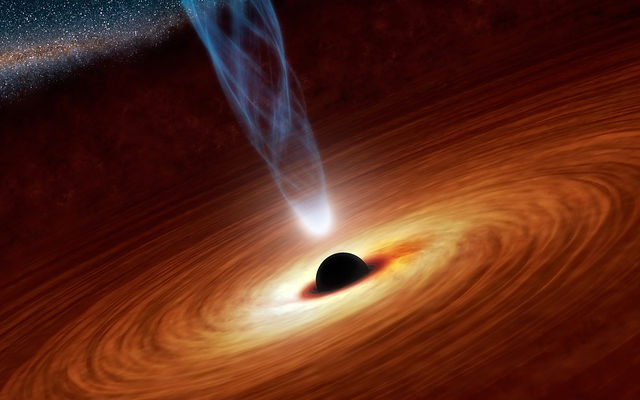THE DEATH OF A STAR...
When a star with a mass of up to eight times that of the Sun runs out of hydrogen, it swells up, cools, and becomes a red giant. Eventually, the giant star ejects its outer layers and becomes a planetary nebula. The ejected gas slowly disperses, leaving behind a white dwarf - the tiny, slowly cooling core of the original star.

Aging stars with eight or more times the mass of the Sun swell into enormous, unstable supergiant stars, which can end their lives in a sudden and spectacular explosion known as a supernova. The exploding star creates an extremely hot gas cloud called a supernova remnant, while its core can collapse to become a rapidly rotating, very dense pulsar or a black hole (where the core collapses in on itself under gravity until it is a hole in space). The material dispersed into space forms clouds, which in turn can give birth to new stars.
Black holes
A black hole is a region of space-time from which gravity prevents anything, including light, from escaping.
How are black holes formed?
When a supergiant star explodes as a supernova, It either forms a neutron star or a black hole. If the stellar mass of the star was larger than 3 solar masses after the supernova explosion, the collapse cannot be stopped and an object known as "black hole" is formed. This is a region in space that has such a strong gravitational field that it draws in everything-even light!
In 2019, The Event Horizon Telescope (EHT) collaboration produced first ever image of a black hole which lies in the center of the M87 galaxy, 55 million light years from earth. The Image showed a bright ring with a dark center, which is the black hole's shadow!
White Hole is a Hypothesis and has not been discovered so far...


STRUCTURE OF A BLACKHOLE:
1. Accretion Disk: Material, such as gas dust and other stellar debris that has come close to a black holee but not quite fallen into it, forms a flattened band of spinning matter around the event horizon called the accretion disk (or disc).
2. Event Horizon: The gravity is very strong here and once objects enter they do not escape. They are pulled inwards to the centre.
3. Singularity: It is the centre of the Black hole where the gravity is the maximum.
TYPES OF BLACK HOLES:
1. Primordial Black holes: These are really really small blackholes. They were formed in very early Universe.
2. Stellar mass black holes: It is formed when a star which is 30 times the mass of the sun runs out of fuel and dies.
3. Supermassive Black holes: These are million times the mass of the sun or billion times the mass of the sun. They are located in the center of the galaxies.
How do Astronomers/ Astrophysicists Detect a Black hole?
If nothing escapes a Blackhole, including light, then how do we know that they even exist?
We know that Black holes exert enormous gravity on nearby obejcts. We can observe them by concentrating on the matter around them.
Black holes are detected as surrounding material (like gas) is funnelled by the force of gravity into a disk around the black hole.
In practice, Binary Star systems are the best way of locating a blackholes. Astronomers have detected many of them!

What will happen if you fall into a Black Hole?
Stephen Hawking described the flight of a fictional astronaut who, passing within a black hole's event horizon, is "stretched like spaghetti" by the gravitational gradient (difference in strength) from head to toe. The reason this happens would be that the gravitational force exerted by the singularity would be much stronger at one end of the body than the other. If one were to fall into a black hole feet first, the gravity at their feet would be much stronger than at their head, causing the person to be vertically stretched. Along with that, the right side of the body will be pulled to the left, and the left side of the body will be pulled to the right, horizontally compressing the person.
Some of the Black Holes Around us...
1. The Unicorn, the nearest black hole to the earth is 1,500 light years away from Earth but still in the Milky way Galaxy. The Unicorn is three times the mass of the sun – tiny for a blackhole.
2. The center of the Milky Way Galaxy has a supermassive Black hole – it has been named Sagittarius A. It is 26,000 light years from Earth.